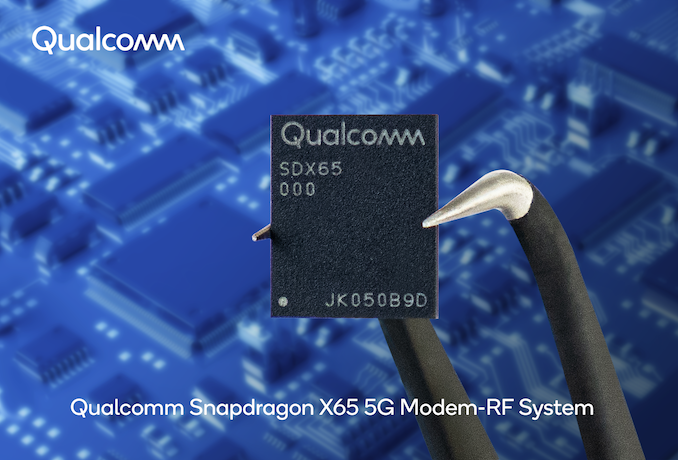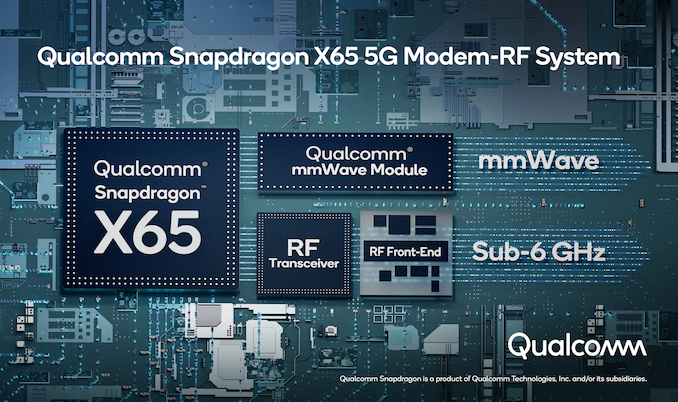Qualcomm Announces X65 & X62 5G Modems on 4nm
by Andrei Frumusanu on February 10, 2021 6:30 AM EST- Posted in
- Mobile
- Qualcomm
- Smartphones
- 5G

Qualcomm yesterday has announced a slew of new 5G communication platforms, representing their next-generation modems, and RF front-end solutions that will be powering the next flagship devices later in 2021 as well as 2022. This includes two new 5G modems in the form of the new Snapdragon X65 and X62, a new RFFE portfolio with new envelope trackers, new antenna tuners, and new power amplifiers, alongside a 4th generation mmWave antenna module that supports more frequency bands and a larger frequency bandwidth.
Starting off with the new X65 modem, it’s a rather large generational upgrade compared to the current X60 modem that increases the amount of frequency bands as well as bandwidth that a vendor can deploy in an end user device.
In terms of sub-6GHz frequencies, the new X65 modem increases the bandwidth from 200MHz to 300MHz, essentially a 50% increase in aggregate spectrum that can be used. Such a wide breadth of spectrum is currently extremely rate in terms of 5G network deployments, but as the US is freeing up new mid-band frequencies for 5G usage over the next years, as well as other global markets deprecate 3G frequencies and reallocate them into 5G usage, we’ll be seeing more possible carrier aggregation combinations across larger variety of frequency bands.
On the mmWave side, things have also seen improvements as the available bandwidth goes from 800MHz to 1000MHz, and now adopts support for the TDD 41GHz n259 band, important for mmWave deployments in countries such as China and Japan.
The new modem, when aggregating across sub-6GHz and mmWave networks with the new increased bandwidth capabilities thus advertises maximum download speeds of up to 10Gbps. Of course, such peak figures aren’t too realistic in the real world, but they do showcase the vast increase in spectrum bandwidth available, which will translate to better transmission speeds in crowded situations.
Alongside the super-high-end X65 modem, we’re also seeing the release of the X62, which is essentially its little brother. In terms of frequency bands and standards capabilities, it’s of the same calibre as the X65, however it differs in terms of its spectrum bandwidth capabilities; sub-6GHz is reduced to 120MHz, and mmWave is reduced to 300MHz across 4 carriers, rather than 10. Undoubtedly this modem solution will be targeting devices at lower price points than the X65 flagship.
Interestingly, both new X65 and X62 modems are manufactured on a 4nm node – this should be Samsung’s 4LPE node which is a further iterative improvement of their current 5LPE technology.
The new 5G modem solutions and their RFFE companion chips are set to hit the market in late 2021.











54 Comments
View All Comments
eek2121 - Wednesday, February 10, 2021 - link
The oldest iPhone in my house is 4 years old and Apple claims the battery is at 81% according to settings. I bought my iPhone 11 Pro Max at launch and the battery is at 99%.Unashamed_unoriginal_username_x86 - Friday, February 12, 2021 - link
Buy an Android and do as the plants doalso my 3Ah phone still lasts a workday at 4 years old, as well as performing acceptably for music, reading and Youtube/Twitch on 6.0.1, SD625 and 4GB ram
That said we will never see 10Gb speeds from ISPs. I hope those companies physically feel their bones coalify
Spunjji - Friday, February 12, 2021 - link
The PC paradigm isn't the only way to get things done.lmcd - Tuesday, February 16, 2021 - link
Maybe not, but I felt pretty futuristic swapping out my PinePhone motherboard (I got one of the beta "Braveheart" boards). Performance on the chip they chose sucks, but I wouldn't be shocked if I'm able to upgrade my board to a (still mediocre but not mind-numbingly so) RK3566 board in a couple years, and keep the display/assembly still.RSAUser - Wednesday, February 10, 2021 - link
Samsung 5/4NM needs someone to come up with a measurement tool.The fact that their 5NM doesn't even compete with TSMC 7NM, and their 4 will probably only match the original 7nm points to how badly its a marketing thing and lots of people who don't understand the difference will be mislead.
weilin - Wednesday, February 10, 2021 - link
This skew in nodes have been a thing for decades now. Some say the last measurable technology was 90nm, others argue 65nm... 45nmm... But, the point is, the number hasn't matched up with actual minimum useable feature size for a very long time now. This is even more true when the fabs switched to FinFets. The only rule today is smaller is better and that's only comparable to nodes within a specific foundry.For Reference:
TSMC 7nm is a full node shrink from TSMC 16nm
Intel 10nm is approximately between TSMC 7nm in terms density/characteristics...
weilin - Wednesday, February 10, 2021 - link
Addendum:TSMC 6nm is an refinement of 7nm (its only about 20% denser)
TSMC 5nm is closer to the traditional node shrink from 7nm (about 80% denser)
Spunjji - Friday, February 12, 2021 - link
Right on.I've never understood the people "will be mislead" angle. The sort of people who would be mislead don't read or care about manufacturing nodes, and the people making the complaint are always aware of the problem (even when they don't fully understand it).
MrCommunistGen - Wednesday, February 10, 2021 - link
I don't mind the short article. It gets all the important details without a huge investment in time to write the article or read it. The only thing I might have wanted would be a table comparing the X65, X62, and maybe one or two previous generations of modems.As for the modems themselves, Qualcomm is checking the right boxes for year over year incremental improvements: More aggregate bandwidth, more bands, higher carrier aggregation count, node shrink.
I'll take more capability at (hopefully) measurably lower power consumption.
I'm assuming there's no mention on whether these modems will be discrete, integrated into future SoCs, or both?
Oberoth - Thursday, February 11, 2021 - link
When will Samsung's nodes be ready for something a little bigger like Nvidia's Lovelace? What high power processes will be ready by the end of this year?How is their 3nm GAA tech coming on? Samsung claimed mass production would be this year.